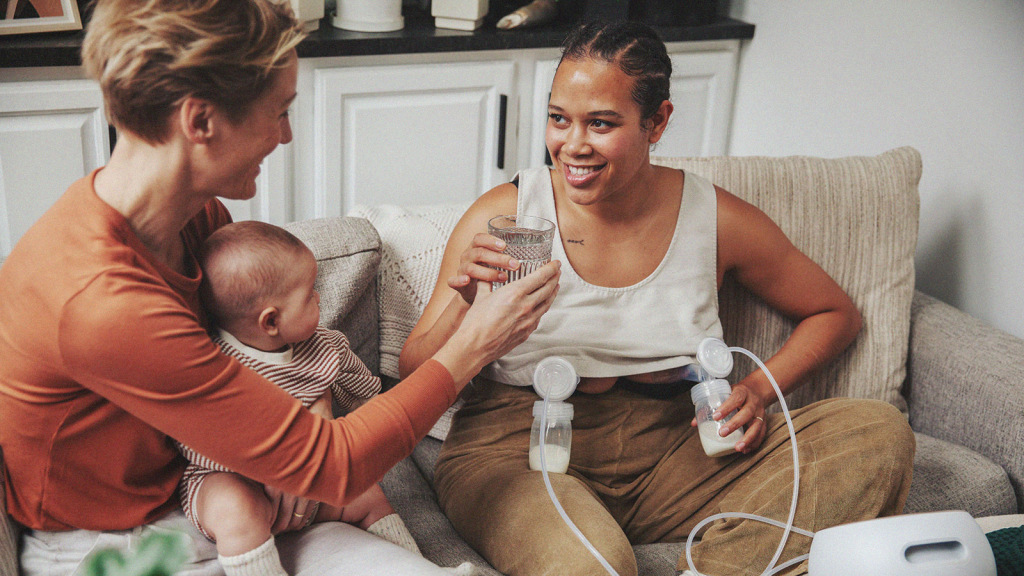Plugged ducts or mastitis? Signs you should know and how to tell the difference
Here’s what an IBCLC has to say about common mastitis symptoms and how to treat them
When breastfeeding or pumping just doesn’t feel right, parents know. For first-time parents, this feeling and the associated symptoms can be nerve-wracking, and it may not be entirely clear what exactly is wrong. Is what you’re experiencing a plugged duct or mastitis? Or is there something else going on? We asked our partner Katie McGee, RN, IBCLC at Special Care Lactation Services to explain clogged milk duct symptoms and signs of mastitis, how to tell the difference between the two, and when it’s time to see your International Board Certified Lactation Consultant (IBCLC).
Ask the IBCLC: Signs and symptoms of mastitis and plugged ducts
What is the difference between clogged milk ducts and mastitis?
A plugged (or clogged) duct occurs when an area of the lactating breast does not properly drain milk, leading to an obstruction of milk flow. This may feel like a little nodule or engorged section of the breast. Plugged ducts tend to come on gradually and typically affect only one breast.
Parents with a plugged duct may experience symptoms, including:
- A small or large lump — this may leave a section of engorgement in the region of the plug
- A tender, swollen feeling in the area that isn’t draining
- A more subtle area of tenderness or pain
- More pain before a feeding session
- Discomfort when nursing on the affected side
- Decreased milk supply and/or pumping output from the affected breast
Mastitis, on the other hand, is an inflammation of the breast commonly caused by an obstruction or infection of the breast. It usually occurs in the first two to three weeks of nursing but can happen at any stage in lactation. Compared to a plugged duct, mastitis comes on quickly and causes more widespread, systemic symptoms. Mastitis usually only affects one breast, though it can happen in both.
Although local symptoms are generally the same as with a clogged milk duct, there are some unique to mastitis, including:
- A fever of 101.3 or higher with chills and flu-like symptoms such as aching and malaise
- Heat, swelling, and pain in the affected breast are generally more intense than with a plugged duct
- A segment of the breast may appear red or red streaks may be present
- Broken skin on the nipple may show obvious signs of infection
- Blood, mucus, or pus is present in milk
- Expressed milk appears to be lumpy, clumpy, gelatinous, or stringy (Your baby can still drink this milk, or you can strain the lumps out)
- Milk has a higher sodium content than usual, leading to a salty taste
How do you know if you have a clogged milk duct?
The main cause of both plugged ducts and mastitis is milk statis, or when milk remains in the nipple or breast instead of coming out through nursing or pumping.
Other plugged-duct precursors include:
- Engorgement
- Latching problems
- Ineffective suck or tongue-tie
- Nipple pain
- A sleepy or distracted baby
- Oversupply
- Hurried feedings or limiting baby’s time at the breast
- A blocked nipple pore
- Pressure on the duct from fingers, a tight bra or clothing, prone sleeping, or a diaper bag
- Inflammation from injury, or a bacterial or yeast infection
Those are the main causes, but other potential contributing factors include:
- Changes in the pattern of breast milk removal due to pain
- Teething
- Pacifier use
- Lifestyle changes such as returning to work or baby suddenly sleeping longer
- Scheduled feedings
- Abrupt weaning
Stress, fatigue, anemia and weakened immunity often precede both plugged ducts and mastitis, and an unresolved plugged duct can easily escalate to mastitis. Sore, cracked, or bleeding nipples offer a point of entry for infection, and a hospital stay can increase your exposure to infectious organisms. Having a history of mastitis is a contributing factor, too.
How do you treat plugged ducts or mastitis?
Treatment is similar for both, but it is better to aggressively resolve a plugged milk duct to avoid mastitis. Do not decrease or stop nursing or pumping, as this increases potential complications. Extra nursing or pumping generally gets things back to normal faster, so nurse frequently and empty your breasts of milk thoroughly. Use heat, a warm compress, or a gentle massage before nursing and loosen your bra and any constrictive clothing to aid in expressing milk. Position your baby for easy nursing while resting, and when you are unable to breastfeed, ensure you are expressing milk frequently and thoroughly.
It is safe to take antibiotics while breastfeeding, but they’re not always needed to treat mastitis. Most doctors recommend a 10-14 day oral antibiotic treatment to prevent relapse. Do not discontinue treatment earlier than prescribed. Some parents choose exclusively natural treatments. A bruised feeling may remain in the area for a few days to a week after a plugged milk duct or mastitis has resolved, so get extra help around the house and take it easy for a couple of days. You may notice stringy or thickened milk as a plugged duct or mastitis is clearing up.
How do you prevent mastitis?
The best thing you can do is proactively avoid situations that may cause breast milk to become trapped in your breast. There are other precautions parents can take, and just being in tune with your body and how you’re feeling is one of them. However, some parents just seem to be more prone to plugged ducts and mastitis than others.
How can a breast pump help with plugged ducts and mastitis?
Breast pumping can help in several ways, especially when it comes to preventing plugged ducts from turning into mastitis. When your baby isn’t hungry, but there’s milk left in your breasts, use a breast pump to get rid of that extra milk and avoid further blockage.
What else can I do to avoid and treat plugged ducts or mastitis?
Talk about your symptoms with an International Board Certified Lactation Consultant. They can help figure out what may have led to this complication and how best to avoid it in the future. The Lactation Network connects families with 90-minute in-home or in-office visits covered by insurance. These IBCLCs will be able to provide you with a wealth of information and understanding on how to avoid mastitis as well as treat any other breastfeeding problems you may be facing. They can also assess your breast pump for potential contributing factors to plugged ducts or mastitis (such as improperly sized flanges or breast shields) and also check the frequency, length, and efficacy of your pumping sessions.
Parents who have experienced either plugged ducts or mastitis know just how inconvenient and alarming it can be. If you are experiencing any of the above symptoms, or if something just doesn’t seem right, call your doctor. It’s better to exhaust all possibilities than to let things get worse. Contact the team at The Lactation Network. We can connect you with an IBCLC who can help you find a pump that works for you.
We’re here for you, every step of the way. We work with your insurance to provide in-home, in-office, or telehealth visits with an IBCLC.




